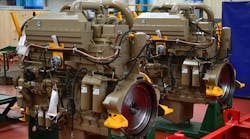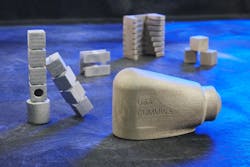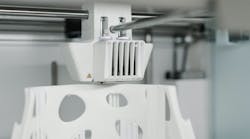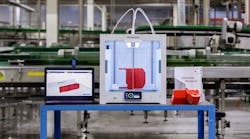There is no such thing as a silver bullet in manufacturing. No single production technology or methodology has the ability to efficiently or cost-effectively conquer every challenge. Instead, manufacturers need to best match the tools at their disposal to the challenges at hand.
For proponents of additive manufacturing, the key has often been ensuring that the maturing technology is regularly in the mix. After all, with the right applications, it is difficult to beat the benefits the technology adds to the equation.
Fortunately, when companies make strategic investments in additive, including understanding where it can make a difference, efforts can quickly pay dividends.
Case in Point
Cummins Inc. is finalizing its first production part using binder jet technology, marking a significant milestone in the Columbus, IN-based company’s additive manufacturing and Industry 4.0 journey.
The part, now moving through Cummins’ production part approval process (PPAP) for formal approval, is a Cummins Emission Solutions (CES) lance tip adapter used in high horsepower engines. A critical emissions component in Cummins engines, the lance tip adapter atomizes and injects diesel exhaust fluid into the engine exhaust stream to reduce the amount of nitrogen oxides (NOx) emitted from Cummins’ engine systems.
“This is incredibly exciting, as it signifies yet another significant milestone in our 3D and additive manufacturing roadmap,” said Tim Millwood, vice president of global manufacturing. “We’re on the cusp of being able to leverage a broad range of additive technologies to print the parts we need, using the right technology and at lower costs and increased speeds.”
Producing this part through additive manufacturing provides several additional benefits, including a lighter-weight design, improved geometry for fluid and airflow, and the elimination of the added complexity of cross-drillings. The company hopes to have final approval of the part and to start official production later this year.
Commitment Paying Off
In April 2019, Cummins announced its investment in binder jet technology, where a print head moves across a bed of powdered metal and selectively deposits a liquid binding agent in the shape of the part cross-section, bonding these areas together to form a solid part one layer at a time.
Depending on the complexity of the part, the technology can print 60 to 100 times faster than other laser-based printing processes, allowing high-volume production with this technology. And, unlike traditional machining, the binder jet printer can take nearly 100% of the leftover powder from the printed part, recirculate it through the system and reuse it in the production of other parts.
Jacob Brunsberg, binder jet product line leader with GE Additive explains the key to getting more additive components into vehicles rests with the belief that binder jet is now a viable manufacturing technology to differentiate products while meeting cost, quality, and scale. “This includes the belief from organizations and the broader industry will allow designers to fully embrace binder jet with the confidence that their designs have a path to production—at scale and cost,” he says. “This is the reason why we are partnering with industry leaders to ensure mutual alignment to production needs for high volume automotive production. The announcement from Cummins is the first such proof point and milestone that will hopefully start to propel the path forward more rapidly.”
“We are very excited about this technology and feel that this will be a game-changer. We see the technology being used for manufacturing several parts for all our products and in all the regions we operate in,” Prafulla Neema, Cummins program director of manufacturing, says.
The commitment continued in 2020 when Cummins established an Additive Manufacturing Lab within the company’s Manufacturing Engineering Development Center. The purpose of the lab is to develop and validate the industrialized binder jet additive manufacturing process. Cummins’ Engineering teams are taking this opportunity to gain experience and skillset in designing for additive manufacturing as the technology advances.
Of course, as with any relatively new technology, it takes time for the familiarity and understanding to reach critical mass, explains Brunsberg. “The more people who become proficient in additive, and how and where it can be most successfully deployed, then the quicker production applications will grow. Additive technology solves many but not every application,” he says. “However, we are confident that additive will help shape the future of powertrains and chassis, as well as a host of other industrial applications. This will allow for more efficient internal combustion infrastructures and pave the way for energy transition into the future enabling fuel cells, battery cooling, e-motors, and hydrogen infrastructures.”
Ongoing Partnership
Currently, the Cummins Additive Manufacturing and Engineering teams are working on designing and printing several additional concept parts, with the hopes of finalizing more parts yet this year. Cummins currently has two second-generation binder jet printers, one at its Additive Manufacturing Lab in Columbus, Indiana, and one at GE Additive’s Disruptive Innovation Lab near Cincinnati, Ohio.
Cummins and GE Additive are actively partnering to develop third-generation binder jet technology, which will support an industrialized solution with even higher throughput, improved quality, and lower cost.
The cost and cycle times of these machines make them well-suited for producing parts for Cummins’ aftermarket customers and those needed in low volumes. Since selling the first metal 3D-printed part in 2019, Cummins has approved twenty different part numbers, shipping nearly 350 parts using its suite of additive technologies.
The partnership between GE Additive and Cummins is confirmation that business cases with a true return on investment for additive exist today. “Aligning around requirements and expectations of factory floor production, and ensuring we have reliable and scalable solutions today and for the future,” says Brunsberg. “Additionally, our partnership with Cummins ensures we have the right materials, processes, and technology to address key application objectives and innovation needed to successfully support its technology roadmaps.”
The keys to success going forward? “Ensuring we keep on learning the various aspects of the technology development, focus on understanding and fixing gaps, and having adequate resources needed,” says Neema.















